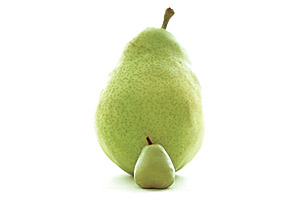
(2 of 4)
Keeping the food flowing — and the prices low enough for people to continue buying it — requires a lot of industrial-engineering tricks, and those have knock-on effects of their own. Up to 10 million tons of chemical fertilizer per year are poured onto fields to cultivate corn alone, for example, which has increased yields 23% from 1990 to 2009 but has led to toxic runoffs that are poisoning the beleaguered Gulf of Mexico. Beef raised in industrial conditions are dosed with antibiotics and growth-boosting hormones, leaving chemical residues in meat and milk. A multicenter study released just two days after the obesity report showed that American girls as young as 7 are entering puberty at double the rate they were in the late 1990s, perhaps as a result of the obesity epidemic but perhaps too as a result of the hormones in their environment — including their food. And for out-of-season foods to be available in all seasons as they now are, crops must be grown in one place and flown or trucked thousands of miles to market. That leaves an awfully big carbon footprint for the privilege of eating a plum in December.
The food wars are fought on multiple fronts, but it's the battle over meat that generates the most ferocious disagreement. Americans have always been unapologetic carnivores, which befits a nation that grew up chasing buffalo and raising cattle across endless stretches of open plains. But lately things have gotten out of hand. The U.S. produces a breathtaking 80 billion lb. of meat per year, with poultry alone making up 35 billion lb. It's now common knowledge that the animals are raised in mostly miserable conditions, jammed together on factory farms and filled with high-calorie, corn-based feed that fattens them up and moves them to slaughter as fast as possible. It can take up to two and a half years to raise a grass-fed cow, while a feedlot animal may face the knife after just 14 months.
The idea of animals living such short, brutish lives introduces an element of altruism into the organic-vs.-commercial debate over meat that isn't there for other foods. Just this month, Ohio Governor Ted Strickland brokered a truce between animal-rights activists and farmers in his state to improve the living conditions of hogs, veal calves and hens; that agreement followed similar reforms enacted in California in 2008.
"When you're raising something with a circulatory system and a nervous system, they deserve care," says Bev Eggleston, the owner of EcoFriendly Foods, a decidedly nonindustrial farm in Moneta, Va., that produces cattle, hogs, veal, lamb and poultry. Eggleston's animals live in fields and coops, not feedlots and cages. The farm has a petting zoo, and the doors of the slaughterhouse are open to visitors so they can see the clean and as-humane-as-possible conditions in which the animals are killed. "I want to speak for the animals," Eggleston says. "When I pull a knife, I want them to know their gift is being received."
There are material advantages to that kind of humane treatment. Cattle that eat more grass have higher ratios of omega-3 fatty acids to omega-6s, a balance that's widely believed to reduce the risk of cancer, heart disease and arthritis and to improve cognitive function. Take the cows out of the pasture, put them in a feedlot and stuff them with corn-based feed, and the omega-3s plummet.
"The levels are almost undetectable after three months," says Ken Jaffe, a former physician who now runs Slope Farms, an open-air cattle farm in the Catskill Mountains of New York. The big beef manufacturers concede that while the ratio for omega-6s to omega-3s is 1.5 to 1 for grass-fed cows, it leaps to 7 to 1 for those that are grain-fed. But industry reps challenge the significance of those numbers. "The best ratio hasn't been determined yet in terms of nutritional balance," says Shalene McNeill, a registered dietitian working for the National Beef Cattlemen's Association, an industry group. "And it's important to remember that this is just one small part of a consumer's overall diet."
Farm-raised animals are also higher in conjugated lineoleic acids, fatty acids that, according to studies of lab animals, may help reduce the risk of various cancers. What's more, animals not raised on feedlots have less chance of spreading E. coli bacteria through contact with other animals' manure, though the industry insists it is making improvements, with better spacing of animals on the lots and better cleaning methods in slaughterhouses.